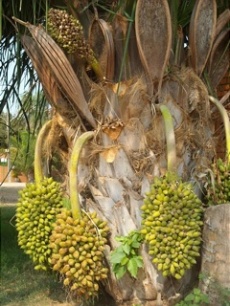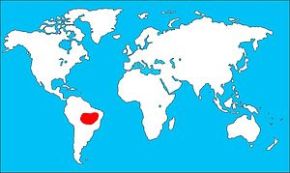The Hyacinth Macaw (Anodorhynchus hyacinthinus), or Hyacinthine Macaw, is a parrot native to central and eastern South America. With a length (from the top of its head to the tip of its long pointed tail) of about 100 cm (3.3 ft) it is longer than any other species of parrot. It is the largest macaw and the largest flying parrot species, though the flightless Kakapo of New Zealand can outweigh it at up to 3.5 kg. While generally easily recognized, it can be confused with the far rarer and smaller Lear’s Macaw. Habitat loss and trapping wild birds for the pet trade has taken a heavy toll on their population in the wild, and as a result the species is classified as Endangered on the International Union for Conservation of Nature‘s Red List,[1] and it is protected by its listing on Appendix I of the Convention on International Trade in Endangered Species of Wild Fauna and Flora (CITES).
Description
The largest parrot by length in the world, the Hyacinth Macaw is 100 cm (3.3 ft) long from the tip of its tail to the top of its head and weighs 1.2–1.7 kg (2.6–3.7 lb).[2][3]Each wing is 388–425 mm (15.3–16.7 in) long.[2] The tail is long and pointed.[2] Its feathers are entirely blue, lighter above and darker on its wings.[2] It has a large black curved beak. It has a lappet of bright-yellow bare skin on the left and right of its face adjacent to the base of its lower beak and an eyering of yellow bare skin encircle each eye. J[4] Male and female are identical in external appearance, and juveniles resemble adults except they have shorter tails and the yellow on their faces is paler.[2]
Food and feeding
The majority of the hyacinth macaw diet is nuts from native palms, such as acuri and bocaiuva palms.[5] They have a very strong beak for eating the kernels of hard nuts and seeds. Their strong beaks are even able to crack coconuts, the large brazil nut pods andmacadamia nuts. The acuri nut is so hard that the parrots cannot feed on it until it has passed through the digestive system of cattle.[5]In addition, they eat fruits and other vegetable matter.
In the Pantanal, Hyacinth Macaws feed almost exclusively on the nuts of Acrocomia aculeata and Attalea phalerata palm trees.
CONSERVATION
The Hyacinth Macaw is an endangered species due to overcollection for the cage bird trade andhabitat loss.[6] In the 1980s, it is estimated that at least 10,000 birds were taken from the wild.[6]Throughout the macaw’s range, habitat is being lost or altered due to the introduction of cattle ranching and mechanised agriculture, and the development of hydroelectric schemes.[6] Annual grass fires set by farmers can destroy nest trees, and regions previously inhabited by this macaw are now unsuitable also due to agriculture and plantations. Locally, it has been hunted for food, and the Kayapo Indians of Gorotire in south-central Brazil use its feathers to make headdresses and other baubles. While overall greatly reduced in numbers, it remains locally common in the Brazilian Pantanal, where many ranch-owners now protect the macaws on their land
Aviculture
This macaw is a popular pet and it requires a large cage, for its wingspan is more than 16 inches. Macaws should have toys and of course require regular food and fresh water.
http://www.facebook.com/petsplanetdo







